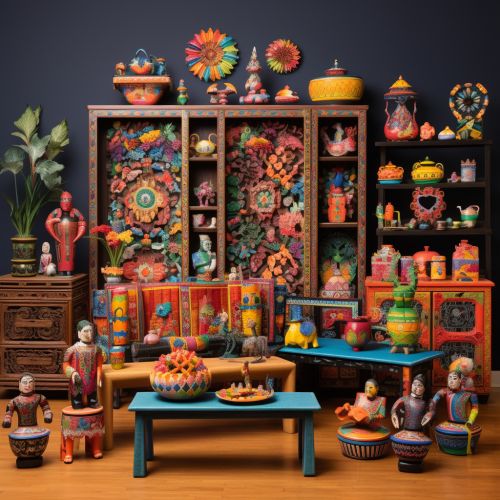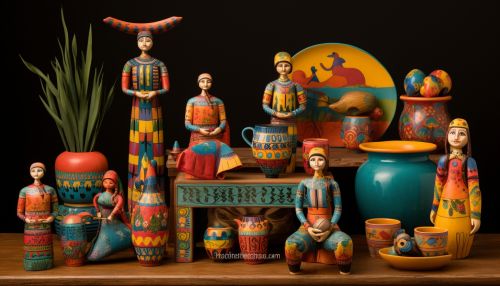Folk Art
Definition and Overview
Folk art encompasses a range of visual and material expressions that are rooted in traditional cultures and communities. Unlike fine art, which is often characterized by formal training and institutional recognition, folk art is typically created by self-taught artists or artisans. It is often reflective of a community's shared cultural heritage, values, and traditions.


History and Origins
While the term "folk art" was not coined until the 19th century, the practice of creating art within community and cultural contexts has been a part of human history for millennia. From the cave paintings of prehistoric societies to the intricate textiles of indigenous cultures, folk art has served as a means of communication, expression, and identity formation across time and space.
Characteristics
Folk art is characterized by its diversity, reflecting the unique cultural contexts in which it is created. However, several common characteristics can be identified across different forms of folk art:
- Community-Centered: Folk art is often created within and for a specific community. It reflects shared cultural values, traditions, and experiences.
- Self-Taught Artists: Unlike fine art, which is often created by formally trained artists, folk art is typically created by self-taught artists or artisans.
- Functional and Decorative: Many forms of folk art, such as pottery, textiles, and furniture, serve both functional and decorative purposes.
- Traditional Techniques and Materials: Folk art often utilizes traditional techniques and materials that are readily available in the local environment.
Types of Folk Art
Folk art can take many forms, depending on the cultural context and available materials. Some common types of folk art include:
- Textiles: This category includes quilting, embroidery, rug making, and other forms of fabric art. Textiles often carry symbolic meanings and can tell stories about the community and its history.
- Ceramics: Folk ceramics range from functional pottery to decorative figurines. They often feature traditional designs and motifs.
- Woodwork: This includes carved figures, furniture, and architectural elements. Woodwork can be both functional and decorative.
- Metalwork: Folk metalwork can include jewelry, tools, and decorative objects. Techniques can range from blacksmithing to intricate filigree work.
- Painting and Drawing: Folk paintings and drawings often depict scenes from daily life, historical events, or religious and mythological stories.
Folk Art Around the World
Folk art is a global phenomenon, with unique expressions in every culture:
- North America: In the United States and Canada, folk art traditions include quilting, decoy carving, and Pennsylvania Dutch hex signs. Native American tribes also have rich traditions of beadwork, pottery, and weaving.
- Latin America: Latin American folk art includes Mexican Talavera pottery, Peruvian retablos, and Brazilian wood carving.
- Europe: European folk art traditions include Russian matryoshka dolls, Norwegian rosemaling, and Hungarian embroidery.
- Asia: Asian folk art includes Chinese paper cutting, Indian rangoli, and Japanese sashiko quilting.
- Africa: African folk art includes Ghanaian kente cloth, Moroccan ceramics, and South African beadwork.
- Oceania: In Australia, New Zealand, and the Pacific Islands, folk art traditions include Aboriginal dot painting, Maori carving, and Hawaiian quilting.
Folk Art Today
While folk art is rooted in tradition, it is not static. Contemporary folk artists continue to innovate, incorporating modern themes and materials into their work. At the same time, folk art traditions are being preserved and revitalized through community initiatives, museums, and cultural festivals.
